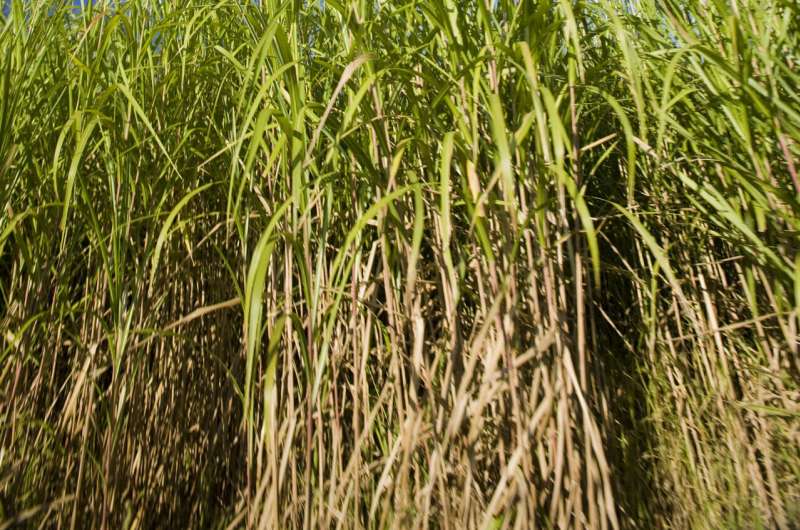This article has been reviewed according to Science X's editorial process and policies. Editors have highlighted the following attributes while ensuring the content's credibility:
fact-checked
peer-reviewed publication
trusted source
proofread
Genetics of host plants determine what microorganisms they attract, finds study

Plants often develop communities with microorganisms in their roots, which influences plant health and development. Although the recruitment of these microbes is dictated by several factors, it is unclear whether the genetic variation in the host plants plays a role. In a new study, researchers from the University of Illinois Urbana-Champaign explored this question and their work can help improve agriculture productivity.
"Previously, researchers have only looked at what kind of microbes are present in association with plants, but not what might be driving the formation of these communities and how we might be able to control these drivers through plant breeding," said Angela Kent (CABBI), a professor of natural resources and environmental sciences.
Microbes form complex communities called microbiomes in and around the roots of plants. The host plants can dictate which microbes are invited into their roots—known as endophytes—using chemical signals. They can also alter the soil properties around the roots to influence which microbes can grow around the root surface or rhizosphere.
However, in order to breed plants based on what microbes they associate with, researchers first need to understand the extent to which plant genomes can influence the rhizosphere microbiome.
To answer this question, the researchers studied two native silver grass species—Miscanthus sinensis and Miscanthus floridulus. These plants are considered potential bioenergy crops because they require lower nutrient concentrations to achieve more growth compared to traditional crops.
The study was conducted in 16 sites across Taiwan and included a range of environmental conditions, such as hot springs, mountain peaks, and valleys, to represent all possible environmental extremes. The researchers collected 236 rhizosphere soil samples from randomly selected Miscanthus plants and also isolated the microbiome inside the roots.
"Although the scale of this study was unprecedented, we were mindful of the plant protection and quarantine regulations. We processed the samples in Taiwan to extract the endophytic microbial community and collect the rhizosphere microbiome," Kent said.
The researchers used two types of DNA sequencing techniques in their study. The microbiomes in and around the roots were identified using the DNA sequence of bacterial and fungal rRNA genes, focusing on the part of the genome that is unique to each species. The variation in the plant genome was measured using microsatellites, which are small pieces of repeating DNA that can distinguish even closely related plant populations.
"The samples were collected 15 years ago when the project was too large for the sequencing capabilities at the time. As the cost of sequencing came down, it allowed us to revisit the data and take a closer look at the microbiome. During sample processing, we also inadvertently extracted plant DNA, and we were able to use that as a resource for genotyping our Miscanthus populations," Kent said.
"We screened the host genome sequences for insights into how they can affect the microbiome," said Niuniu Ji, a postdoctoral researcher in the Kent lab. "I discovered that the plants affect the core microbiome, which was exciting."
Although plant microbiomes are very diverse, the core microbiome is a collection of microbes that are found in most samples of a particular set of plants. These microbes are considered to play an important role in organizing which other microbes are associated with the plant and helping with host growth.
The core microbiome that the researchers found in Miscanthus included nitrogen-fixing bacteria that have been found in rice and barley in other studies. All these microbes play a role in helping the plants acquire nitrogen, which is a vital nutrient for plant growth. Recruiting nitrogen-fixing microbes may help the plants adapt to different environments, but importantly, this capability contributes to the sustainability of this grass as a potential bioenergy crop.
On the other hand, the influence of the genetic variation among the plants had a lower effect on the rhizosphere microbiome, which was more strongly affected by the soil environment. Even so, the plants placed a greater emphasis on recruiting fungi compared to other microbes.
The researchers are interested in parsing out which genes play a role in influencing the microbiome. "The microsatellites do not have a biological function and are not representative of the whole genome. It would be nice if we could sequence the whole Miscanthus genome and figure out how the genes affect nitrogen fixation," Ji said.
"Crop breeding is based on yield. However, we need to take a wider look and consider how microbes can contribute to crop sustainability," Kent said. "The appeal of working with wild plants is that there is vast genetic variation to look at. We can identify which variants are good at recruiting nitrogen-fixing microbes because we can use fewer fertilizers on these crops. It's an exciting possibility as we embark on adapting these plants for bioenergy purposes."
The study "Host genetic variation drives the differentiation in the ecological role of the native Miscanthus root-associated microbiome" was published in Microbiome.
More information: Niuniu Ji et al, Host genetic variation drives the differentiation in the ecological role of the native Miscanthus root-associated microbiome, Microbiome (2023). DOI: 10.1186/s40168-023-01646-3
Journal information: Microbiome
Provided by University of Illinois at Urbana-Champaign




















